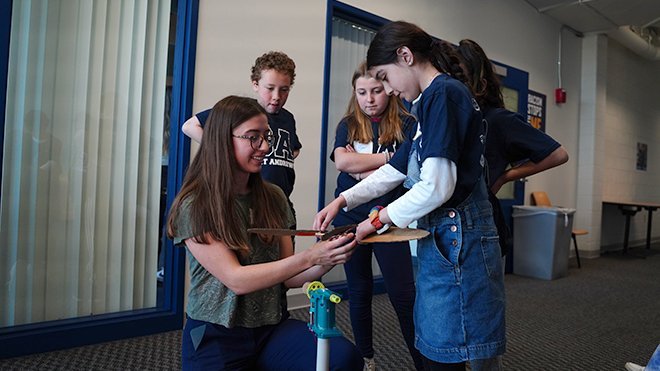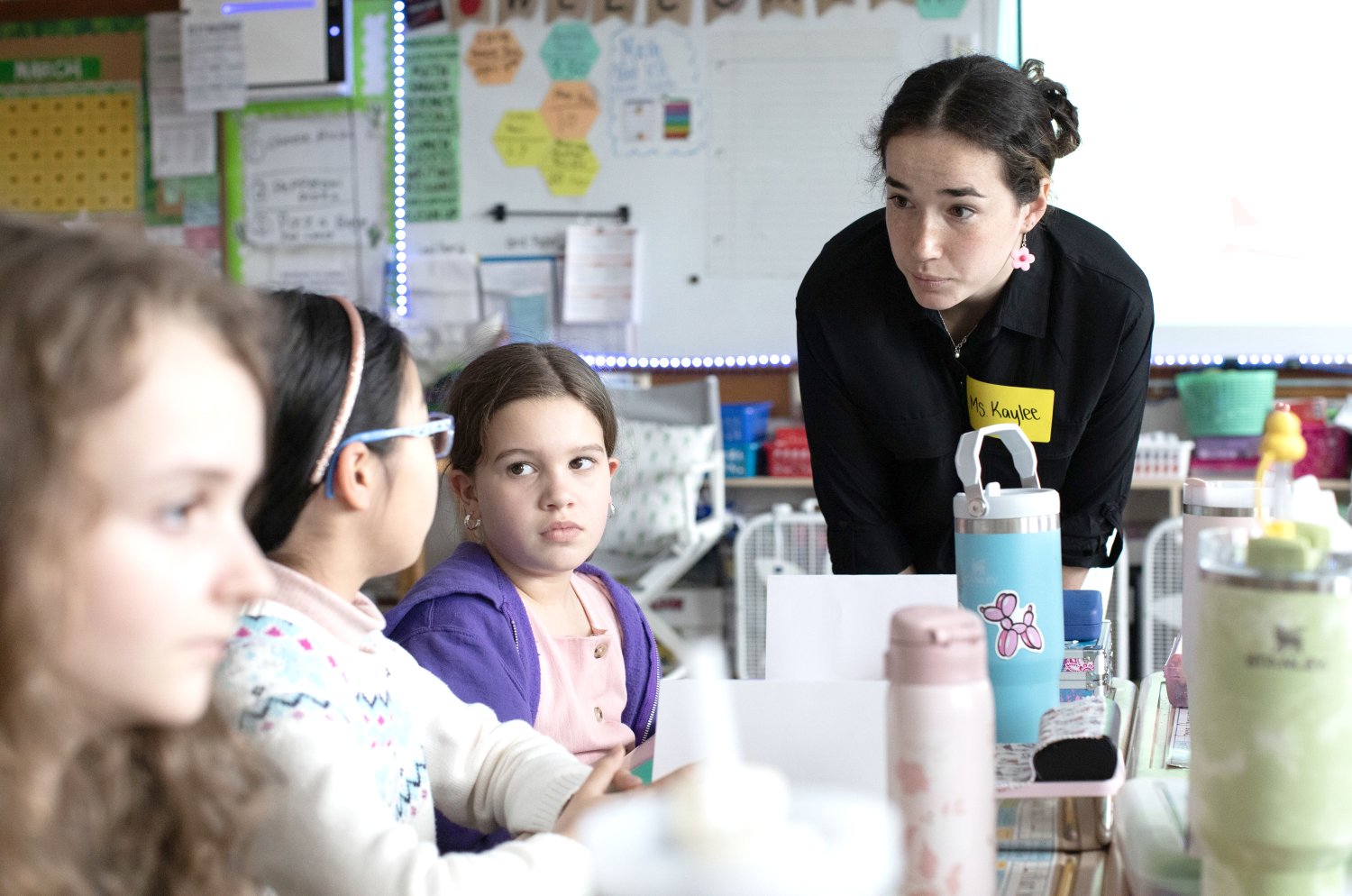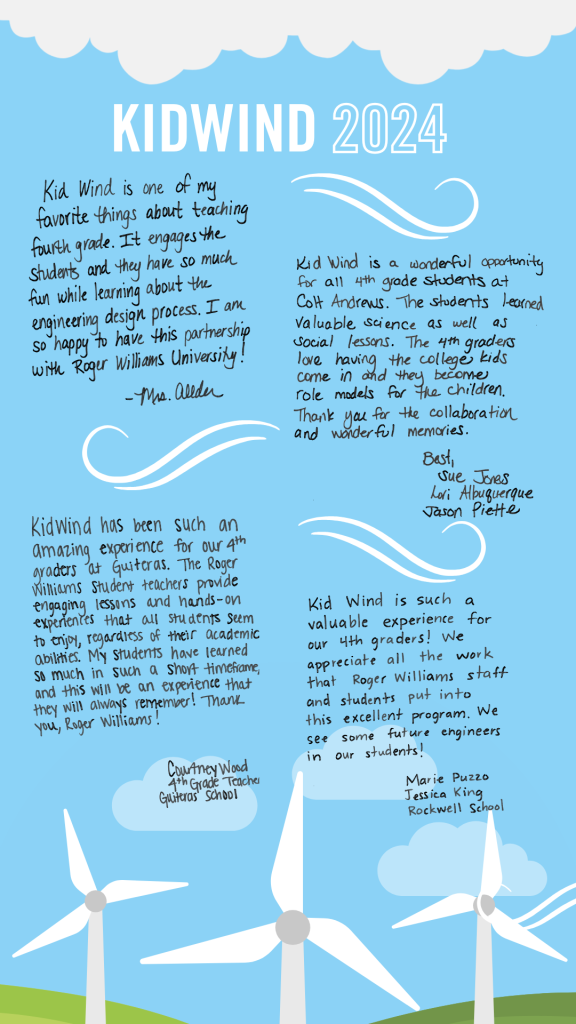RWU Students Guide Fourth Graders Through Wind Energy Exploration and the Engineering Design Process
KidWind, which has reached more than 1,000 fourth graders, pairs Engineering and Education majors to teach young students about renewable energy through designing and testing their own model-scale wind turbines.

BRISTOL, R.I. – The Roger Williams University Campus Recreation Center was transformed into a bustling hub of scientific exploration as nearly 200 fourth graders brought model-scale wind turbines they created to whirl to life in a “wind test tunnel.” Clutching their marvels of engineering with a mixture of pride and nervousness, young students exchanged thoughts about how their design would perform before handing them over to RWU Engineering students, who positioned them in the tunnel and connected them to a multimeter. A hush fell over the room as the wind tunnel hummed with activity, and all eyes darted between the bladed creations and a nearby monitor where a digital readout gauged each model’s impact on renewable energy production. With each successful experiment, the air filled with jubilant cheers and high-fives were exchanged between the builders, their faces beaming at the validation of their hard work and creativity.
This activity was part of KidWind, a partnership between RWU and the Bristol-Warren Regional School District (BWRSD), which brought 199 fourth graders and their teachers – and their 46 turbines – to the university on April 23 to celebrate engineering and STEM education. During the spring semester, RWU Engineering and Education majors teamed up to teach wind energy and engineering design to the entire BWRSD fourth-grade class, across four elementary schools.
The initiative started in 2019, when RWU Associate Professor of Engineering Maija Benitz and Professor of Science Education Li-Ling Yang saw an opportunity for RWU to help fill a gap in the local school district and give students of both disciplines a revolutionary experiential learning opportunity. Now, in 2024, KidWind has reached more than 1,000 fourth graders.
“It’s both humbling and thrilling to realize that over 1,000 fourth graders have participated in the KidWind project since its inception,” Benitz said. “The combination of Engineering and Education majors is a key component to the success of the community engagement project. The engineers lend their technical expertise, while the education majors provide pedagogical know-how, and the interdisciplinary teaching teams thrive in the classrooms while deepening and diversifying their skills.”
A Powerful Combination
This year, 34 Education students in Yang’s Teaching Inquiry Science in the Elementary School class and 17 Engineering students in Benitz’s Wind Turbine Design course collaborated to create and teach new lesson plans on engineering design in the fourth-grade classrooms. They led the young students through how to design and build their own model-scale wind turbines, and each group of fourth graders chose their own optimal blade design and constructed their turbines from recycled materials (a BWRSD sustainability initiative).
“In the classroom we do a lot of reading about engineering, but we don't always get to do the hands-on aspect,” said Hilary Pietz, a fourth-grade teacher at Guiteras Elementary School in Bristol. “With KidWind, students work through the whole engineering design process, complete hands-on experiments, and get the opportunity to tie it all together at the end by building their own wind turbines. It resonates much more than if they were to just read about it.”

In addition to testing their wind turbines, the fourth graders presented their designs to a panel of experts, featuring engineers from SouthCoast Wind and TPI Composites. They also got a few more lessons in the engineering design process led by RWU students, including working together on a structural design for a paper bridge that could support Hot Wheels cars, attempting to reach the tallest height using cups and wooden sticks, and building handheld catapults from popsicle sticks and rubber bands.
Winds of Change
Now in its fifth year, KidWind continues to thrive bolstered by generous funding from multiple sources, including the SouthCoast Community Foundation Grant, Rhode Island Foundation Strategic Initiative Grant, Hassenfeld Community Projects Fund, RWU Foundation to Promote Scholarship & Teaching, and local sponsor TPI Composites of Warren, R.I. This was especially true for this year thanks to a $30,000 grant from the SouthCoast Community Foundation that enabled the engagement of nine research assistants – comprising five Education and four Engineering majors, all of whom were participants in last year’s KidWind – as well as a lead research assistant, Stephanie Rioux ’23, who studied Elementary Education and has been involved with KidWind since 2022.
According to Yang, the support provided by the increased number of research assistants helped elevate the quality and thoroughness of the lesson plans. “Our research assistants have played a pivotal role, offering nuanced guidance and constructive feedback to the interdisciplinary teams, thereby elevating the lesson plans crafted by our Education and Engineering students.”
Rioux's return to KidWind stemmed from a profound appreciation for the project's impact on her career trajectory. "This project was so formative to my eventual career path, as the opportunity to participate in KidWind and provide engineering lessons in fourth-grade classes sparked my interest in science education,” she said. “As an educator, you learn the most when you’re actually in the classroom because that’s when everything from your lectures comes together and you realize you know how to do this.”
A fifth-grade educator at Webster Avenue Elementary School in Providence, Rioux took the opportunity to give back to the RWU community by sharing her expertise and knowledge with the next generation of educators. “The most rewarding aspect is being able to guide Education majors from their first lesson plan to their last and seeing their growth and confidence in their ability to teach science and engineering.”

Preparing the Leaders of Tomorrow
By working collaboratively across disciplines, educators ensure that students are actively engaged in their learning process while engineers guarantee the scientific accuracy of the lessons.
“KidWind taught me how to work well with others from different disciplines to create fun lesson plans that met both education and engineering requirements,” said Edvin Caniz-Garcia, a senior Mechanical Engineering major from West New York, N.J. “If I ever want a managerial position, I will be able to use my KidWind experience of supervising teams and managing tasks as a stepping stone into my future career.”
Also this year, a team of six Engineering students mentored by Benitz were tasked with redesigning the KidWind wind tunnel for their Engineering Design Senior Capstone project. The group sought to enhance the previous iteration’s ability to be transported, stored, and manufactured and to enhance its effectiveness as a wind tunnel used for educational purposes. Through iterative testing and design adjustments, such as reversing the wind direction and improving collapsibility for easy transport, the team created a more functional and user-friendly 4-foot-by-4-foot wind tunnel.

Rachel Shaw, a senior Mechanical Engineering major from North Smithfield, R.I., said her involvement in the wind tunnel rebuild and KidWind overall has provided invaluable experience in versatility and communication. “KidWind teaches you how to adapt on your feet and how to speak to different audience levels, which as an engineer is so important because odds are when you are giving a presentation you’re not just talking to engineers, you’re also speaking to people of other backgrounds.”
Sarah Hardiman, a junior Elementary Education major from Cranston, R.I., said working on KidWind helped her better understand the process of planning and implementing a lesson plan. “I've learned that it's perfectly normal to adapt your lesson plan and change things based on what's better for the students. Since we worked with our research assistants and professors very closely, it was easy to get their perspective and make any changes.”
Members of the Engineering Design Senior Capstone project shared their work at RWU’s annual Student Academic Showcase and Honors on April 24, while KidWind research assistants had the opportunity to present at the first Dream with STEAM Conference at RWU on April 27.